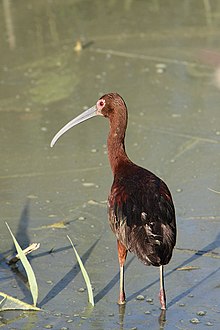Plegadis chihi
| White-faced ibis | |
|---|---|
 |
|
| Breeding plumage | |
| Scientific classification | |
| Kingdom: | Animalia |
| Phylum: | Chordata |
| Class: | Aves |
| Subclass: | Neornithes |
| Infraclass: | Neognathae |
| Superorder: | Neoaves |
| Order: | Pelecaniformes |
| Family: | Threskiornithidae |
| Genus: | Plegadis |
| Species: | P. chihi |
| Binomial name | |
|
Plegadis chihi (Vieillot, 1817) |
|
| Synonyms | |
|
Plegadis falcinellus chihi |
|
Plegadis falcinellus chihi
Plegadis falcinellus mexicana
The white-faced ibis (Plegadis chihi) is a wading bird in the ibis family Threskiornithidae.
This species breeds colonially in marshes, usually nesting in bushes or low trees. Its breeding range extends from the western United States south through Mexico, as well as from southeastern Brazil and southeastern Bolivia south to central Argentina, and along the coast of central Chile. Its winter range extends from southern California and Louisiana south to include the rest of its breeding range.
The white-faced ibis is very similar to the glossy ibis in its non-breeding plumages, but it tends to be slightly smaller and the plumage color is somewhat warmer. Breeding adults have a pink bare face bordered with white feathers (rather than a bluish bare face with no bordering feathers), a grey bill, and brighter colored, redder legs. Adults have red eyes year-round, whereas glossy ibises have dark eyes. Juveniles of the two species are nearly identical.
Winter Quintana, Texas
Non-breeding plumage
The white-faced ibis occurs in Canada, the United States, Central America and the southern half of South America. In 2012, the total population size was estimated to be 1.2 million individuals, and increasing. The IUCN rates it as being of Least Concern.
The white-faced ibis bears a strong resemblance to the related glossy ibis and in the past was sometimes considered to be a subspecies of the glossy ibis. Another theory was that upon coming to the New World, a small isolated glossy ibis population evolved to become its own separate species. However, recent molecular phylogenetic studies show that the white-faced ibis may actually be paraphyletic. In fact, members of the white-faced ibis populations in the United States appear to be more closely related to glossy ibises than to members of white-faced ibis populations in Southern Brazil.
...
Wikipedia

